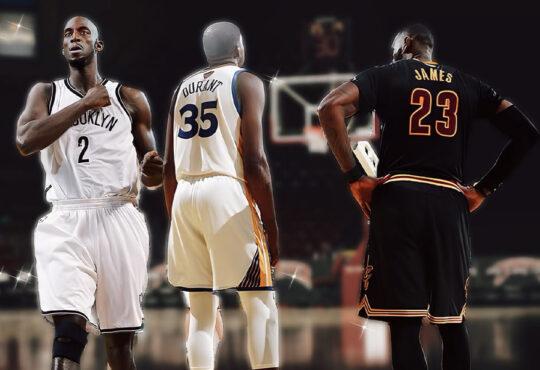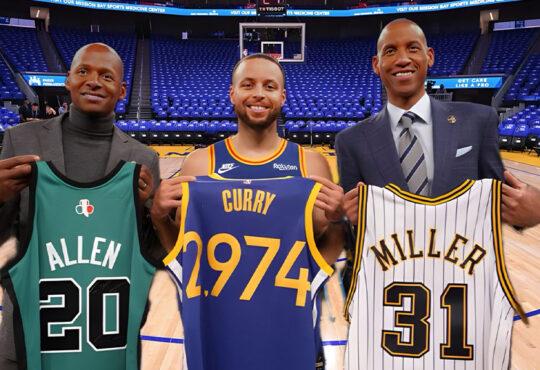
How Does the NBA Conference System Work?
The league is composed of 30 teams, 29 in the United States and 1 in Canada.
How Does the NBA Conference System Work? The current league organization divides 30 teams into two conferences of three divisions with five teams each. The current divisional alignment was introduced in the 2004–05 season.
Reflecting the population distribution of the United States and Canada as a whole, most teams are in the eastern half of the country: 13 teams are in the Eastern Time Zone, nine in the Central, three in the Mountain, and five in the Pacific.
The playoff bracket is also split up into each conference, meaning that a team from the Eastern Conference can’t play a team from the Western Conference before the NBA Finals.
However, teams can play against teams in other conferences during the regular season. Typically teams will play Division Rivals 4 times, Conference Rivals 3 times, and teams from the opposite conference twice to fill out the bulk of their 82-game regular-season schedule.
Why the NBA is split into two conferences?
There are a couple of reasons why the league decided to split the league up into Eastern and Western conferences.
First, there were some concerns regarding the playoff bracket if all teams were sharing one side. It wasn’t a major concern, but when conferences were introduced, few knew how this type of change would work regarding the postseason at the time.
There were NBA experts and decision-makers who were strongly against the addition of conferences. They felt that weaker teams would get into the postseason more often if their conference is weak, making the league as a whole unfair.
The league got the point that this kind of situation could arise every once in a while but they implemented the rule of conferences anyway. In recent history, the Eastern Conference looks far worse than the Western Conference but these things usually even themselves out at some point.
On top of all that, the NBA thought that adding conferences would be crucial in lowering travel time for teams, something even more prescient in modern times as we face climate change. The teams that play in the Eastern Conference would go up against teams in the same conference more than they would team in the opposite conference. Instead of having to travel across the country many times, teams could stay closer to their home arena by playing conference opponents more often than not.
What do the current conference and division system look like?
As mentioned, the 30 NBA teams are split into two conferences that are further split into three divisions per conference. This is how that system looks at the moment.
Eastern Conference:
Atlantic Division: Boston Celtics, Philadelphia 76ers, Toronto Raptors, Brooklyn Nets, and New York Knicks
Central Division: Milwaukee Bucks, Chicago Bulls, Cleveland Cavaliers, Indiana Pacers, and Detroit Pistons
Southeast Division: Miami Heat, Atlanta Hawks, Charlotte Hornets, Washington Wizards, and Orlando Magic
Western Conference:
Northwest Division: Utah Jazz, Denver Nuggets, Minnesota Timberwolves, Portland Trail Blazers, and Oklahoma City Thunder
Pacific Division: Phoenix Suns, Golden State Warriors, Los Angeles Clippers, Los Angeles Lakers, and Sacramento Kings
Southwest Division: Memphis Grizzlies, Dallas Mavericks, New Orleans Pelicans, San Antonio Spurs, and Houston Rockets
Has the NBA thought about removing conferences?
There have been numerous times when Adam Silver and the rest of the league officials have talked about taking away conferences. However, the thought hasn’t been acted on at all in the last couple of years and likely won’t be changed anytime soon.
The fans were often talking that the conferences should at least be removed due to the playoff seeding. This was because the Eastern Conference had teams with losing records make the playoffs while the West was seeing 45+ win teams get eliminated in the regular season.
Why and how the conference system should be changed?
It is widely known that there are some issues revolving around the placement of a few teams. For instance, both the New Orleans Pelicans and the Memphis Grizzlies are geographically in the East and are playing within the Western Conference.
So essentially either team is playing on a cross-country road trip every time they are on the road. Now, there are multiple issues this causes for both the league and individual teams.
Let’s start off with travel expenses. The League implemented a “green” road trip plan a couple of seasons ago. The goal was to lower emissions and lessen the financial burden on the traveling team.
The league did this by shortening the road trips but forcing more games into less time on the road. Financially speaking, any team that has to travel cross country to play a team in their conference will bear a larger financial burden than that of a team in the correct conference.
Another reason is simply the physical part of the game. Four games in five nights are difficult on the body and eight-game road trips are stressful as well, but each is magnified when the league is trying to mold its image.
As you can imagine, from personal experience or stories, it is difficult to sleep on an airplane.
Let’s take a look at a part of the Memphis Grizzlies’ schedule a season ago.
The Grizzlies played Phoenix at home, then they traveled to Toronto, then flew back home to play the Miami Heat, followed by a trip to New York the next night then back home to play the Clippers, followed by a trip to DC to go back home to play Portland and then visited New Orleans and Chicago.
That was more than 9,000 miles in 19 days. Which is an issue that could have been made easier if the league would re-align the system.
Money consideration
Professional sports are built on proximity rivalries, but if you have a team in the Western Conference that resides in the Eastern part of the country, it makes it difficult to build rivalries. For example, the Knicks vs Celtics rivalry or Chicago vs Detroit has been built for years but teams such as the Grizzlies can not build a local rivalry simply because they do not play in the same conference as the team near them.
The average sports fan has to have a reason to invest their time into a game. Once they invest their time, they could become a fan and invest more time into your franchise. A fan that cares more will spend more to watch the team they care about.
Change and Financial Viability for Owners and Fans
The current system can’t change just because the current one is unfair. Western owners will agree that there is a disparity, but Eastern teams and owners are shortsighted and disincentivized to let go of their guaranteed playoff spots.
The current 82-game structure would be a difficult one to change. Most owners, Eastern or Western, would not want to give up any revenue on that front. Changing that monstrosity of a season is mathematically complicated and irrelevant.
However, changing the structure of the Conference style single-elimination playoff format could be a win for everybody involved.
Currently, 16 teams make it to the playoffs out of 30 total teams. Over half of the NBA makes it, and then each match-up in the playoffs is a maximum 7 series stretch.
This makes for the maximum total number of games that could potentially be played 105.
The format can be made more exciting for the fans while justifying increased revenues for owners, too.
The top 16 teams could be seeded into the playoffs by some absolute metric, like wins, or some combination of things that is not solely the placement within the respective conference.
The games don’t need to be segregated by conference. Instead, we can execute a double-elimination style format, where we not only implement a main, winner’s bracket, but also a loser’s bracket.
The current 82-game season is madness for any team. It is hard work regardless, and while it should help place you well in the post-season, it should not disregard you completely if you’re doing slightly below where you need to be. It should give you a small chance of making it.
In this layout, we would start with 16 teams in the Winner’s Bracket, as we did in the original conference system. However, teams would play a best-of-five instead of a best-of-seven. This won’t hurt the total games played, however, because of the addition of a Loser’s Bracket.
With the Loser’s Bracket, we would add 8 more teams from the league, boosting the playoff team count to 24.
The 8 additional teams can be picked up by the next eight teams in the league that qualify or by wildcard qualifications. These teams will play the first round of losers that are knocked out from the Winner’s Bracket. These will play the first round in the Loser’s Bracket with the next eight seeds in the NBA for either a best-of-three or a best-of-one. Whichever the league decides is better.
There are a few reasons that this is far better than the current system.
The games are far more equal as the post-season moves on. Whereas in the previous system, the Western Conference definitely got more competitive while the Eastern Conference remains the same, or worsens.
The 5 region NBA system
Another idea for changing the current conference system is a replacement with a so-called 5 region NBA system.
Per this system the teams would be separated into the following regions:
Pacific Region: Sacramento, Portland, Golden State, LA Lakers, LA Clippers, and Utah
Big West Region: Denver, Phoenix, Oklahoma City, San Antonio, Dallas, and Houston
Lakes Region: Minnesota, Milwaukee, Chicago, Detroit, Indiana, and Cleveland
Atlantic Region: New York, Brooklyn, Boston, Philadelphia, Washington, and Toronto
Southeast Region: Miami, Orlando, New Orleans Pelicans, Charlotte, Atlanta, and Memphis
According to this idea, a team would play the closest team five times in the season which is 10 games. A team would then play the other three teams in the region four times each. This is 12 games, for a running total of 22.
Then a team would play teams from two other regions three times each. This is 36 games, for a running total of 58. And finally, a team would play teams from the remaining two regions twice each. This is 24 games, for a running total of 82.
So the question that pops out is which two regions a team would play three times a year?
Well, that would rotate annually, much as the NFL handles interconference play.
In Year 1, the teams of the Pacific would theoretically face the teams of the Lakes and Big West regions three times each and the teams of the Atlantic and Southeast regions twice each. In Year 2, the Pacific teams would face the Big West and Southeast thrice each and the Lakes and Atlantic twice each. In Year 3, they’d face the Southeast and Atlantic thrice each and the Lakes and Big West twice each. In Year 4, they’d face the Atlantic and Lakes thrice each and the Southeast and Big West twice each. And the cycle repeats.
Let’s see this system by a real live team as an example. Let’s take the Portland Trail Blazers as an example.
Under this plan, Portland would face the Kings and Warriors five times each, the Lakers, Clippers, and Jazz four times each, the 12 teams in the Big West and Lakes regions three times each and the 12 teams in the Southeast and Atlantic regions twice each. Next year, the schedule against the other Pacific teams would remain, but they’d get three games against each of the 12 Big West and Southeast teams and two games (a home-and-home) against each of the 12 Lakes and Atlantic teams. And so on.
This doesn’t achieve perfect balance, anything that maintains 82 games and respects the logistic and emotional need to emphasize regional play can do that. But there is definitely some macro balance.
This makes a conference-free playoff system plausible. You can seed teams 1-16 knowing that the schedule is relatively balanced, unlike the current schedule, where East teams have had a much easier path to 50 wins.





